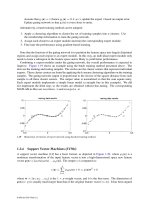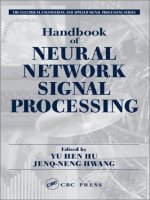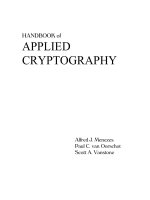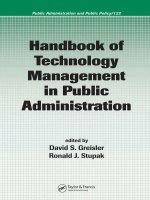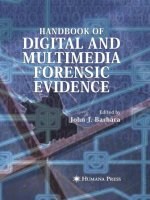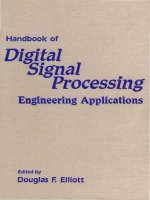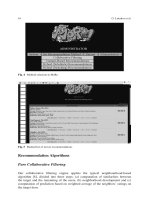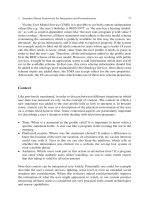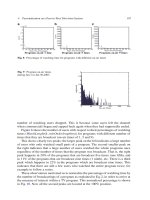handbook of digital & multimedia forensic evidence
Bạn đang xem bản rút gọn của tài liệu. Xem và tải ngay bản đầy đủ của tài liệu tại đây (1.99 MB, 147 trang )
Handbook of Digital and Multimedia Forensic
Evidence
Handbook
of Digital
and
Multimedia Forensic
Evidence
Edited by
John J. Barbara
© 2008 Humana Press Inc.
999 Riverview Drive, Suite 208
Totowa, New Jersey 07512
www.humanapress.com
All rights reserved. No part of this book may be reproduced, stored in a retrieval system, or transmitted in any form or
by any means, electronic, mechanical, photocopying, microfilming, recording, or otherwise without written permission
from the Publisher.
All papers, comments, opinions, conclusions, or recommendations are those of the author(s), and do not necessarily
reflect the views of the publisher.
This publication is printed on acid-free paper.
ANSI Z39.48-1984 (American Standards Institute)
Permanence of Paper for Printed Library Materials
Cover design by Karen Schulz
Production Editor: Michele Seugling
For additional copies, pricing for bulk purchases, and/or information about other Humana titles, contact Humana
at the above address or at any of the following numbers: Tel.: 973-256-1699; Fax: 973-256-8341; E-mail:
; or visit our Website: www.humanapress.com
Photocopy Authorization Policy:
Authorization to photocopy items for internal or personal use, or the internal or personal use of specific clients, is
granted by Humana Press Inc., provided that the base fee of US $30.00 per copy is paid directly to the Copyright
Clearance Center at 222 Rosewood Drive, Danvers, MA 01923. For those organizations that have been granted a
photocopy license from the CCC, a separate system of payment has been arranged and is acceptable to Humana Press
Inc. The fee code for users of the Transactional Reporting Service is: [978-1-58829-782-2/08 $30.00].
Printed in the United States of America. 10987654321
e-ISBN 978-1-60327-124-0
Library of Congress Control Number: 2007931072.
About the Editor
Mr. Barbara has worked in forensic crime laboratories for over 30 years and
currently supervises the Digital Evidence Section (Computer Forensics) in a state
crime laboratory in the United States. Mr. Barbara became an American Society of
Crime Laboratory Directors/Laboratory Accreditation Board (ASCLD/LAB) Legacy
Inspector in 1993 and an ASCLD/LAB ISO 17025 certified Technical Assessor in
2004. He has participated in over 25 laboratory inspections for ASCLD/LAB, serving
as an Inspector, Site Leader, Team Captain, and Technical Assessor. He has inspected
the disciplines of Controlled Substances, Toxicology, Firearms and Toolmarks, Trace
Evidence, Questioned Documents, and Digital & Multimedia Evidence (Computer
Forensics, Forensic Audio, Image Analysis, and Video Analysis). On three occasions,
he has assisted ASCLD/LAB with the training of their Digital & Multimedia Evidence
Inspectors and was appointed by the ASCLD/LAB Board as Chairperson of its Digital
& Multimedia Evidence Proficiency Review Committee. He is a member of the
Editorial Advisory Board of Forensic Magazine and author of a regular column in
Forensic Magazine titled “The Digital Insider.” He has presented numerous infor-
mation programs and workshops and has authored many articles pertaining to Digital
& Multimedia Evidence Accreditation.
v
To Ralph M. “Bud” Keaton for your years of dedicated, uncompromising efforts
to improve the quality of forensic laboratory services provided to the criminal justice
system. You were there at the “dawn” of forensic laboratory accreditation, long before
many of us even understood what accreditation meant. Over the years, you have been,
and continue to be, a constant force promoting the necessity for forensic laboratories
to become accredited. You have ensured that the accreditation process is impartial,
objective, and conducted under the highest standards of ethical practice. Under your
guidance, the Digital & Multimedia Evidence discipline was added to the ASCLD/LAB
accreditation programs. Forensic laboratories that achieve ASCLD/LAB Legacy or
ASCLD/LAB-International accreditation in this discipline (and any of the others that
are offered) can be considered as having attained accreditation from the premier
forensic laboratory accreditation program in the world today. Job well done “Bud!”
Preface
In April 2005, I received a telephone call from Humana Press Senior Editor, Harvey
Kane, inquiring whether there might be a need for a book to be published concerning
the different aspects of computer forensics. During a subsequent meeting to discuss the
current state of available texts covering this topic, I noted to Mr. Kane that there were
several excellent computer forensics books already published and readily available.
Mr. Kane then inquired as to what were some of the commonalities and differences
between those books. My response was that they all discussed computer forensics
analysis in detail. (Indeed, the purpose of one in particular was to guide the individual
to becoming a skilled computer forensics examiner.) Furthermore, I indicated that some
of the books included topics such as different operating systems as well as chapters
on evidence collection and processing. Still others dealt specifically with incident
response. Mr. Kane then asked me two questions: “If a person wanted to pursue a
career in computer forensics, is there any one book currently available that provides
an overview?” and if not, “If you were to write a book on computer forensics, what
topics would you include in the book?” The meeting ended with Mr. Kane asking me
to draft a scope document concerning a possible book on computer forensics.
Shortly thereafter, I attended a local Infragard meeting. The speaker’s topic for
the meeting was incident response and the role that computer forensics can play in
identifying the evidence of a Denial of Service (DoS) attack. After the presentation,
a number of those present asked the speaker such questions as: “What training is
necessary to become an examiner in this field?” “How and where can you obtain such
training?” “Where can you get the software to investigate this type of crime?” “Does
an information technology (IT) person have to be certified?” “How do I go about
obtaining certification?” “What certifications are available?” “What are the legal issues
involved in searching and seizing digital data?” “What education is necessary to be
hired in the IT field?” “What happens if you have to testify in court?”
Over the past several years, I have been asked many of those same questions
by high school and college students and other individuals interested in entering the
computer forensics field. One question in particular stands out: “How and where does
a person look to obtain the necessary information if he or she is thinking of a career
in this field?” All of these questions exemplify how difficult it is at times to obtain
necessary information to make career choices.
As I began to develop an outline and scope document, I reflected back upon the
field as a whole, trying to determine how we got to where we are now. In doing so,
ix
x Preface
I began to identify some issues that should potentially be addressed. All of us are
aware that digital and multimedia data is found everywhere in our society. From the
shoplifter who is captured on video tape to the victim of identity theft, digital and
multimedia data is somehow involved in the analysis of the evidence. Over the past
10 years or so, considerable emphasis has been placed on the need to find, capture,
store, examine, and preserve digital and multimedia data for investigative purposes.
There are many practitioners who, on a daily basis, perform complex analyses to
gather necessary information for subsequent courtroom litigation. The educational
skills of these practitioners range from the self-taught to those with doctoral degrees
in applicable fields of analysis. However, multifaceted analyses can at times become
overwhelming, particularly regarding differentiation of the techniques involved. For
instance, consider the following real-case scenario:
Several digital cameras at a convenience store allegedly capture an armed robbery of the
store by several suspects. A hard drive from the video surveillance system is submitted
to a computer forensics examiner for analysis. The hard drive contains 24 hours of
multiplexed video. The investigator believes that somewhere on the hard drive is the video
of the armed robbery. Along with the hard drive, the investigator submits a compact disk
(CD) containing digital images of several potential suspects. The examiner is requested
to analyze the hard drive, find the video of the armed robbery, capture and enhance the
video images of the robbery suspects, and compare those images to the ones provided
on the CD. Furthermore, the examiner is also requested to decipher, if possible, what the
suspects said during the armed robbery.
This scenario raises all sorts of questions: “What type of analysis will the examiner
be performing?” “Do we know for sure if the examiner will be performing computer
analysis, video analysis, audio analysis, imaging analysis, or all four?” “Does the
examiner have sufficient training?” “What is the experience level of the examiner?”
“Where did the examiner obtain the necessary tools?” “Have they been validated and/or
verified?” “What type of standards and controls will be used during the analysis?”
The scenario depicts the need for conformity or uniformity in defining, handling,
and examining digital and multimedia evidence. Evidentiary items may include both
analog and digital media and/or the information contained therein. For practicality
purposes, digital and multimedia analysis can be grouped under one discipline, the
Digital & Multimedia Evidence discipline. This discipline can be further broken down
into at least four subdisciplines: Forensic Audio Analysis, Computer Forensics, Image
Analysis, and Video Analysis.
Many national and international organizations, such as the Scientific Working
Group on Digital Evidence (SWGDE), the International High Technology Crime Inves-
tigation Association (HTCIA), the Digital Forensic Research Workshop (DFRWS), the
Institute of Computer Forensic Professionals (ICFP), and the International Organization
on Computer Evidence (IOCE) exist to provide guidance and leadership to the practi-
tioners of the discipline. Furthermore, journals such as the International Journal of
Digital Evidence, the International Journal of Digital Forensics & Incident Response,
and others provide a forum for the dissemination of technical information. Other print
media, such as Forensic Magazine, contain articles that discuss relevant topics. Organi-
zations such as the International Association of Computer Investigative Specialists
(IACIS) offer certifications to examiners to help ensure reliable analytical results. Even
with this wealth of available resources, there continues to be one constant need in this
Preface xi
emerging field that is not likely to change: an overview of the major elements of the
discipline itself. Until now, there has been no one general source or reference that ties
together such diverse topics as:
•
The foundation of the discipline, analog and digital data
•
How the Internet and Internet-related crime has affected our society
•
The applicable laws on search and seizure
•
What educational skills and training are needed to become an examiner
•
Certification and accreditation
•
Information security in the private and governmental sector
•
How to investigate cybercrime
•
How to collect evidence at a typical crime scene
•
The types of digital and multimedia analysis performed
•
Preparation for courtroom testimony.
This book, Handbook of Digital and Multimedia Forensic Evidence, was put
together with the intent to be that reference. It can serve as a foundation and guide for (a)
students considering a career in this field, (b) the law enforcement investigator assigned
to work cybercrimes, (c) establishing training programs for forensic examiners, (d) the
IT professional, (e) the veteran forensic examiner, and (f) the prosecutor faced with
litigating cybercrime cases brought before a trier of fact. Because there is not any one
person who is totally knowledgeable in all of these topics, a distinguished group of
authors was selected to write individual chapters to address his or her specific areas
of expertise. After reading this book and knowing that technology, techniques, and
analyses change literally week to week, the reader will not become an “expert” in
this field but rather will come away with a greater understanding of this multifaceted
discipline.
John J. Barbara
Contents
Preface ix
Contributors xv
1. The Analog and Digital World
Donald Justin Price 1
2. Training and Education in Digital Evidence
Philip Craiger 11
3. Certification and Accreditation Overview
John J. Barbara 23
4. History, Concepts, and Technology of Networks and Their Security
Rebecca Gurley Bace 47
5. The Digital Crime Scene
Mark M. Pollitt 65
6. Investigating Cybercrime
Philippe Dubord 77
7. Duties, Support Functions, and Competencies: Digital Forensics Investigators
Larry R. Leibrock 91
8. Electronic Evidence and Digital Forensics Testimony in Court
Fred Chris Smith and Erin E. Kenneally 103
Index 133
xiii
Contributors
Rebecca Gurley Bace
Infidel, Inc.
Scotts Valley, California
Philip Craiger
National Center for Forensic Science
Department of Engineering Technology
University of Central Florida
Orlando, Florida
Philippe Dubord
Tampa, Florida
Erin E. Kenneally
University of California San Diego
San Diego Supercomputer Center
La Jolla, California
Larry R. Leibrock
Office of Deputy Secretary of Defense
Joint Improvised Explosive
Device Defeat Organization
Austin, Texas
Mark M. Pollitt
Digital Evidence Professional Services, Inc.
Ellicott City, Maryland
Donald Justin Price
Former Computer Forensic Examiner
for the Florida Department of Law Enforcement
Boyertown, Pennsylvania
Fred Chris Smith
Santa Fe, New Mexico
xv
1
Chapter 1
The Analog and Digital World
Donald Justin Price
Summary
Digital devices shape every aspect of our lives—from online banking to ordering milk when your
refrigerator detects you are low. These advances in technologies have been used to advance and improve
our daily lives and, truly, the way in which we live. Unfortunately, these advances also have a dark side.
Electronic devices are the new weapons of choice used by today’s criminals. These activities range from
sophisticated network intrusion to money laundering to exploiting children. Criminals attempt to hide
behind digital zeros and ones in an effort to protect their identities while exploiting the identities of others.
It is the responsibility of law enforcement and corporate America to understand digital devices and how
to uncover a criminal’s true identity through specialized training, sophisticated software, and a little bit
of luck.
This chapter will introduce you to the world of digital information. It will briefly describe the basic
fundamentals of digital and analog devices. It is not the intent of this chapter to cover every aspect of
digital devices but rather to present a solid foundation of understanding for further detailed study of the
subject matter. Let us start from the beginning; understanding the impact of mathematics.
Key Words: Bitmap, Bits, Bytes, MD-5, Partition, Sectors.
1. The Binary World
Digital information is represented by two states; “0” or “1.” This representation of
two states is referred to as binary. Let us take a quick look at how binary digits are
computed and how they are used to represent human-recognizable characters, numbers,
and symbols. Each binary digit, “0” or “1,” is called a bit. A bit is the smallest unit
processed by digital devices. In order to represent more than two possibilities, digital
information is combined into 8 bits, termed a byte. Each of the 8 bits has a specific
From: Handbook of Digital and Multimedia Forensic Evidence
Edited by: J. J. Barbara © Humana Press Inc., Totowa, NJ
1
2 D. J. Price
Bit Position: 8
th
7
th
6
th
5
th
4
th
3
rd
2
nd
1
st
Value: 128 64 32 16 8 4 2 1
Fig. 1. Value placement within a byte.
value associated with its position. The value assigned to each bit increases from right
to left, by a multiple of two (Fig. 1).
There are a total of 2
8
, or 256, possible combinations within a byte. The American
Standard Code for Information Interchange (ASCII) is a coding-based system that is
used to represent characters, numbers, and various symbols. Each ACSII value has an
assigned byte combination, totaling 256 possible characters, numbers, and symbols.
When referencing an ASCII conversion chart, it is helpful to convert the binary digits
into a decimal (base 10) or hexadecimal (base 16) value. How is this conversion
accomplished?
Presume that we want to convert the following byte, “01010110,” into a decimal
value. Each bit has a specific value associated with its position. As you move from
right to left, the bit’s value becomes more significant. If the binary value is a “1,”
then the value assigned to that placeholder is added. If the binary value is a “0,” then
nothing is added. Now that we have all of the values assigned to each bit, all we have
to do is add them together and get a decimal value of 86 (Fig. 2). Referencing an
ACSII conversion chart, we note that the decimal value of 86 represents the capital
letter “V.”
Now let us look at converting the same byte into a hexadecimal value. When
converting binary to hexadecimal, you first have to break the byte into two 4-bit
segments. This 4-bit segment is called a nibble. Each bit within the nibble has a
specific assigned value, just like the decimal conversion. Combining the values of each
nibble yields the hexadecimal conversion (Fig. 3). Referencing an ASCII table, the
hexadecimal value of 56 represents the capital letter “V,” just as we expected from
the previous example. In a hexadecimal system (base 16), the possible values are from
0 to 9 and A through F, “A” being equal to 10, “B” being equal to 11, and continuing
until “F” equals 16. So why do we use hexadecimal to represent digital information?
We do so simply because it takes less space to represent a single character, number,
or symbol. Each hexadecimal value represents four binary values.
Byte: 0 1 0 1 0 1 1 0
Bit Value: 128 64 32 16 8 4 2 1
Conversion: 0 64 0 16 0 4 2 0
Decimal Value (86): +64 +16 +4 +2
Fig. 2. Converting a byte to a decimal value.
1. The Analog and Digital World 3
Byte: 0 1 0 1 01 10
Bit Value: 8 4 2 1
84 21
Conversion: 0 4 0 1
04 20
+4 +1 +4 +2
Hexadecimal Value: 5
6
Fig. 3. Converting a byte to a hexadecimal value.
2. Digital Recording
Now that we have a very general understanding of the binary world, let us explore
how this information is stored on magnetic devices, such as hard drives, floppy
diskettes, tapes, and so forth. Magnetic storage is based on the physics of magnetism.
The magnetic storage device determines the magnetic property of each particle on a
medium. The particle is either positively or negatively charged. As defined above, this
is a true binary system. For example, a hard drive consists of platters, actuator arms,
and read/write heads. The platters are normally made of aluminum or glass, which
cannot flex. These platters contain a magnetic coating, which is used for data storage.
Three popular types of magnetic coatings are oxide media, thin-film media, and antifer-
romagnetically coupled (AFC) media (1). As the read/write head(s) of the hard drive
move over each magnetic particle, the polarization of the particle will generate a pulse.
Based on the particle’s magnetic orientation between the read/write head, the particle
will generate a positive or negative pulse. This is a very simple and basic description
of how magnetic particles are converted into binary “0” and “1.”
Binary information is stored on magnetic devices in areas called sectors. A sector
is the smallest physical unit that can be used to store digital information. Each sector
contains 512 bytes of storage space. The physical size of a sector is slightly larger,
however; addressing information and error checking consumes a portion of the storage
space. Sectors are organized in centric circles called tracks. The density of the media
determines how many sectors per track the media contains. For example, a floppy
diskette may have between 8 and 36 sectors per track; a higher density hard drive may
have 900 or more sectors per track (2). There are two recording processes possible
when the sectors and tracks are created during the formatting process. These recording
types are referred to as standard and zone recording. The standard recording process
creates the same number of sectors per track across the entire magnetic device. This
creates a major loss of data storage and an overall decrease in efficiency. In other
words, you would have the same number of sectors per track on the innermost circles
as you would on the outermost circles. This inefficiency led to the development of
zone recording. When zone recording is used, there is an increased number of sectors
per track within each track as you move out from the center of the medium.
Each storage unit on a magnetic device must have an address so that the hard
drive knows where to find the data being requested. As magnetic devices have become
more advanced and larger capacities are demanded, the number of addressable sectors
4 D. J. Price
has clearly approached its limit. Each storage unit is identified by using a set number
of bits. The number of bits used in the address scheme is determined by how the
medium is formatted. The formatting process prepares the medium for data storage
and is accomplished within three steps: low-level format, partitioning, and high-level
format. The low-level formatting process physically creates the tracks and divides them
into sectors. Each sector is given its location address, and the data area is filled with
test values (3). The partitioning phase creates partitions on the medium. This allows
multiple filing systems and/or operating systems to coexist. The last and final stage is
the high-level format, which creates the infrastructure needed to properly manage the
files that will be stored on the drive. This entire process is analogous to a new housing
development. Several acres of land are parceled, streets are created, and appropriately
sized lots for new homes are established. If needed, several subdivisions are created,
one being for upscale homes, one for townhomes, one for single-family dwellings, and
so forth. Finally, the homes are constructed in order to manage all of the families that
live within the same community. Let us look at an example of how the formatting
process affects data storage. A FAT16 formatted system uses a 16-bit value to address
each storage unit. Therefore, there are a total of 65,536 addressable storage units. This
limitation dictates that the largest maximum volume size cannot exceed 2 gigabytes.
On the other hand, a FAT32 formatted system uses 32 bits for addressing storage
units. Therefore, a total maximum volume size of 4 terabytes is theoretically possible
(4). A cluster, or allocation unit, is a group of one or more sectors on a disk. This
represents the smallest logical unit in which data can be stored. Figure 4 illustrates an
example of standard recording. In this formatting scheme, each cluster is made up of
four sectors. Therefore, the smallest allocation unit assigned to any file is 2048 bytes.
In the binary world, all types of files are stored magnetically in this fashion:
programming codes, Microsoft Word documents, sound files, and video files It is
the function of the operating system and program(s) to interrupt the ones and zeros
as they are being generated by the read/write heads of the hard disk. Let us look at
an example of a bitmap graphics file. In a bitmap graphics file, each byte represents
specific intensities of the three primary colors, red, green, and blue (RGB). Therefore,
Fig. 4. Example of a cluster.
1. The Analog and Digital World 5
each RGB value contains 3 bytes, each byte representing an intensity of color (5).
Previously discussed was the concept of a byte; it consists of 8 bits. Each of the bits
has a predetermined value associated with its location. The bit farthest to the left is
called the most significant bit, because it has a value of 128. In contrast, the bit farthest
to the right is the least significant bit, because its predetermined value is 1.
When a bitmap image is called by a program, the program will interpret each
byte being generated by the hard drive’s read/write heads. The programming code will
know to read each byte and display the appropriate intensity of RGB and therefore
produce an image that represents the collection of millions of these bytes. Figure 5
shows examples of the binary representation of three different common colors.
The technology of steganography takes advantage of this fact when concealing
files within files. If a bitmap graphics file is used to conceal another file, the steganog-
raphy program will replace the least significant bit within each byte. The file size of
the original bitmap does not change, and the degradation of the image is undetectable
by the human eye.
Another area within magnetic recording deals with random versus linear
recording. Hard drives, floppy diskettes, and zip diskettes benefit from random
recording. This gives the read/write heads of the device control of where to store
the data. The system tries to be as efficient as possible and tends to store files in
the closest available spaces to the read/write heads. The other option is to store the
files sequentially, assuming the space is available. This type of operation is known as
random recording, being able to “jump” around the disk to store digital information.
A magnetic tape is a good example of a device that uses linear recording. This process
has a greater “overhead” when trying to read and write digital information. If the user
requests data that is stored at the end of the tape, the device must forward the tape to
the proper location, wasting valuable time.
Optical media differ from magnetic media in that optical media use the principles
of light to read and write data as opposed to magnetism. Examples of common optical
media would be compact disks (CDs) and digital versatile disks (DVDs). The type
of polymer being used will dictate if a disk is writable and/or rewritable. When the
recording phase of optical media is initiated, a laser light is used to scribe pits into
the polymer material. As the laser light transverses the disk, the reflection of the laser
light is calculated and converted into electrical pulses, which are interpreted as binary
zeros and ones (Fig. 6). Just like in magnetic devices, density plays a critical role in
determining how much data can be stored on any given disk. A DVD has a much
higher density than a CD; therefore, it can store almost seven times the amount of
data.
Binary Code: RGB Value: Displayed Color:
000000000000000000000000 0,0,0 Black
000000001111111100000000 0,255,0 Green
100000001000000010000000 128,128,128 Gray
Fig. 5. Examples of three common colors and their respective binary representation.
6 D. J. Price
0 1 1 0 0 1 0 0 1 1 0 0 1 0 0 1 0 0 1 1 0 0
Polymer
Fig. 6. Profile view of the “lands” and “pits” as observed on optical media.
3. Analog Recording
Analog information is continuous; the transmitted signal is analogous to the original
signal (6). A sound wave is an example of an analog system. The intensity of the sound
is directly proportional to the sound wave. Converting or recording analog information
to its digital counterpart is called digitizing. In the conversion process, the analog
sound waves are broken up into many pieces and converted into numbers and stored
digitally (Fig. 7). The quality of the conversion process is directly affected by the rate
of sampling. Naturally, a higher sampling frequency will generate a higher quality
digital audio conversion. Each specific number generated from the recording phase is
proportional to the voltage level during playback. Just like the RGB values of graphics
files, the bit value plays an important role in audio files.
4. Image Analysis
Digital photography has been well accepted and embraced. The advances of
digital cameras and their corresponding technology has become so mainstream that
professional-grade cameras are within the price range of average consumers. With
the proliferation of digital cameras in society, criminals have taken advantage of this
technology. This has forced law enforcement to develop and refine techniques of
image analysis. There is a definite need for comparing, enlarging, repairing, enhancing,
and analyzing graphics files. With the advances of modern technology, we are able
to accomplish each of these tasks with great precision and accuracy. Gone are the
days of using magnifying glasses and destructive chemicals and processes to analyze
Fig. 7. Digitizing an audio sample.
1. The Analog and Digital World 7
Fig. 8. Example of image header information.
images. Through research and software and technical developments, we are able to
analyze these images and uncover their hidden past or true identity. A simple example
of image analysis would be to determine the manufacturer and model number of a
digital camera that captured a questioned photograph. Using a hex editor program,
the image file’s hexadecimal values can be examined. The beginning part of a file is
called the header information. Various types of information can be contained within
this area. Information such as file type (i.e., Microsoft Word document, JPEG, BMP,
etc.), digital camera information, or program information could be extracted from the
header information. Figure 8 shows an example of the header information within a
digital photograph taken with a Sony Mavica CD-350 digital camera.
Of course, this is an extremely simple example of image analysis. More complex
issues involved with image analysis include, among others, image enhancement, image
authentication, comparison, and stereography detection. Major strides have been made
to perfect this critical need within digital evidence. Sophisticated tools are capable of
bit manipulation within the binary data in order to interpolate and enhance resolution
of imagery.
Mathematical algorithms can be used to authenticate or compare images. MD-5
(Message Digest) is a standard algorithm used in digital evidence and could be used
for comparing digital images. The MD-5 algorithm is a polynomial in which binary
information is introduced that in turn generates a unique alphanumeric sequence. This
MD-5 value can be accepted as a digital fingerprint of the data that was processed.
The odds of any two files generating the same MD-5 hash value are roughly 1 in
3.4×10
38
. Therefore, if two digital photographs need to be authenticated as being exact
duplicates of each other, the file’s binary information could be inserted into the MD-5
hash algorithm. If the alphanumeric values match, then you have reasonable certainty
that the two digital photographs are identical. Keep in mind that this procedure could
be used for any file type, not just digital photographs.
5. Effects of Digital Information in Society
As mentioned in the beginning of this chapter, digital information shapes every aspect
of our lives. It seems we have become more reliant on digital information than on
crude oil. National defense, utility infrastructure, business, and entertainment rely on
digital information. In fact, most of these would not exist in their current forms without
8 D. J. Price
it. So what does this mean for you and me? As we become more dependent on digital
information, it becomes even more important for us to understand the technology
and defend it against individuals who choose to exploit and misuse the technology.
Computers, smart phones, PDAs, and such are becoming smaller and more advanced
yet, at the same time, increasing their capacity to store information. The discipline of
digital evidence must constantly adapt and change with technological developments in
order to be an effective front against digital crime. Digital technology is changing in
four main areas: physical size, storage capacity, processing power, and data security.
Let us take a look at each area and how it affects law enforcement and society.
5.1. Physical Size
From the Motorola razors to ultrathin laptops to the iPod nano, digital information
can be stored anywhere. Individuals can be carrying gigabytes of digital information
in their pockets, around their necks, or even in their watches. This should cause great
concern for law enforcement and society itself. Criminals are now able to store their
incriminating evidence on these (and other) small devices. Officers need to be properly
trained to recognize that virtually any digital device can be/is capable of storing digital
evidence. To avoid being arrested and prosecuted for a crime, one of a criminal’s
best defenses is the concealment of evidence. If the incriminating digital evidence
is never found, charges could not be filed. One simple example of this could be an
individual suspected of Internet fraud. The user’s Internet activity would be crucial
to their prosecution. If the suspect was using a U3 enabled thumb drive, all of the
user’s Internet activity would reside in the thumb drive, not on the computer itself.
If the seizing agent never noticed the thumb drive, critical evidence could be lost
forever. Training and experience is a critical piece to the puzzle. Any sworn law
enforcement officer who executes search warrants should have a basic understanding of
this technology and be able to recognize such critical pieces of evidence. As technology
advances, digital storage devices will take on an array of shapes and sizes. Ink pens
are no longer just ink pens and watches are no longer just watches. They should be
thought of and treated as potential pieces of evidence.
5.2. Storage Capacity
The technology used to store digital information is also constantly changing. The
industry demands not only smaller devices as mentioned above but also large storage
capacities. Consumers want to be able to store entire music collections and family video
footage without a concern for free space. With the advent and proliferation of digital
cameras and digital video cameras, having a storage capacity of 500 gigabytes to 1000
gigabytes is not uncommon for the consumer. As technology of perpendicular recording
becomes more prevalent, storage capacities are going to be increasing exponentially.
This will place a certain burden on law enforcement. Digital evidence examiners will
be required to make well-informed decisions when determining what information to
capture, how to capture the information, and ultimately how to process the enormous
amount of data. The art and science of digital forensics relies on the ability of the
examiner to find the “needle in the haystack.” However, as the needle gets smaller in
size, the haystack is getting bigger.
1. The Analog and Digital World 9
5.3. Processing Power
Processing power is the only area that benefits the criminal as well as law enforcement.
Being able to process more data per second will not only lower the total processing
time but also will allow the examiner to find the data more efficiently. However, this
becomes less effective as storage capacity continues to expand. In an ideal world, a
computer’s processing power would be directly proportional to its storage capacity. As
we all know, our world is far from perfect.
5.4. Data Security
Password protection and encryption are examples of data security. Society must be
mindful of personal information being stored on digital devices. Any digital infor-
mation that could be exploited must be protected. Password protection and encryption
only allow authorized users to access the protected information. Cryptography is the
process of concealing the contents of a file from all except for authorized users. As
cryptographers create more secure algorithms used in data encryption, others will
be testing their vulnerabilities and exploiting any weakness. Encryption schemes and
strong passwords are very effective ways of ensuring data security. This fact alone
should impose great concern to law enforcement when processing digital evidence.
It requires examiners to think “outside-the-box” when dealing with cases known to
involve encryption. Basic encryption schemes need to be understood by examiners.
This understanding will allow them to make sound decisions when seizing digital
evidence. During the execution of a search warrant, just walking into a residence
or business and “pulling-the-plug” on a computer is no longer a viable option.
Seizing agents must be more mindful of encryption programs and must understand
how to best deal with the technology in an already highly stressful situation. If
left unchecked, valuable data could be lost forever. Remember, the main purpose
of encryption is to conceal or secure data from unauthorized access. If the suspect
is using encryption, you can bet that the critical data is secured. However, as
encryption schemes become more secure, so does the technology used to circumvent the
process. Code-breaking software is an indispensable tool to digital evidence examiners.
A weak password or pass phrase coupled with the strongest encryption scheme is
meaningless. “The chain is only as strong as its weakest link” is an effective principle
to apply when using passwords. Code-breaking tools use this fact to exploit the
entire process in order to recover the password and, ultimately, to read the decrypted
file.
Encryption is a two-edged sword. Cryptographers are constantly striving to
develop the world’s perfect encryption algorithm. If such an algorithm exists or is even
possible, the direct effect on our society could be detrimental. A “would-be” terrorist
could use this “perfect” encryption algorithm to conceal their radical views and plans
to commit terrorist acts against any person or country. For this reason, the computer
industry, law enforcement, and intelligence agencies should strive to work together in
an effort to improve software products and digital devices without tying the hands of
law enforcement.
10 D. J. Price
6. Conclusion
Law enforcement and society will always play a cat and mouse game when it comes to
developing technology. As new digital devices are invented, their inherent weaknesses
are determined and exploited. As a result, the developers start the building process all
over again, which ultimately leads to a better and stronger product.
References
1
Mueller, S. (2002). Upgrading and Repairing PCs, 14th ed. Indianapolis: Que, p. 610.
2
Ibid., p. 601.
3
Ibid., pp. 604–608.
4
Ibid., p. 607.
5
Lewis, J., and Loftus W. (2005). JAVA Software Solutions, 4th ed New York: Pearson Education, Inc., p. 95.
6
Newton, H. (2003). Newton’s Telecom Dictionary, 19th ed. San Francisco: CMP Books, p. 61.
2
Chapter 2
Training and Education in Digital
Evidence
Philip Craiger
Summary
Digital forensics is a relatively new science that is becoming increasingly important as tech-savvy
criminals use computers and networks in their illegal activities. Demonstrated competency in digital
forensics requires a varied knowledge and skill set that includes an in-depth understanding of computer
hardware and software, computer networks, forensic science, applicable local, state, and national laws, as
well as the ability to communicate in both verbal and written forms. The purpose of this chapter is to provide
the reader with an overview of education and training in digital forensics. Issues specifically addressed
include differences between education and training; the “core competencies” of the digital forensics
examiner; guidelines on the knowledge and skills students should expect to learn in a college/university
educational program; a description of various types of training programs; as well as pointers to Web
resources for current information on available educational and training programs.
Key Words: Core competencies, Digital forensics, Examination plan, Hashing, IACIS, NW3C, Oper-
ating systems, SWGDE, TWGED.
1. Introduction
Law enforcement and business and industry increasingly encounter crimes that involve
digital evidence. In 2000, the Scientific Working Group on Digital Evidence (SWGDE)
defined digital evidence as “…any information of probative value that is stored or trans-
mitted in a binary form” (1). The new science of digital forensics is the application
of science and technology to the identification, recovery, transportation, and storage
of digital evidence. Digital forensics is a relatively new forensic science compared
From: Handbook of Digital and Multimedia Forensic Evidence
Edited by: J. J. Barbara © Humana Press Inc., Totowa, NJ
11
12 P. Craiger
with biological (e.g., DNA) and physical-based (e.g., Gun Shut Residue (GSR),
explosions, fingerprints, tool marks) forensics. Due to the ubiquity of digital media and
its use in criminal activities, law enforcement, business, and industry, the forensic science
community has become increasingly aware of the importance of digital forensics and
the fact that it must be addressed as a profession and a science given its importance in
many court cases. Accordingly, it is crucial that those involved in the recovery, exami-
nation, and preservation of digital evidence have the requisite training and education to
deal effectively with the growing amount of evidence they will encounter.
The reader is presented with two caveats concerning this chapter. First, technology
changes quickly—technologies become obsolete, and new technologies are created on
an almost daily basis. These changes have a significant effect upon the practice of
digital forensics, making it a “moving” target that requires practitioners to update their
knowledge and skills to remain current of these changes. The second caveat concerns
existing educational and training programs. Discussions of specific educational and
training programs in this chapter are intentionally limited as they change on a regular
basis. Discussions of specific vendor-supplied training and university programs would
make this chapter essentially obsolete or incomplete by the time of publication. Conse-
quently, in this chapter the focus is upon the fundamentals of digital forensics (i.e.,
principles, procedures, knowledge, and skills that are likely to be important for the
foreseeable future). The reader can then use this information to compare and contrast
university educational programs and training programs to determine the extent to which
these programs meet these criteria. Discussed are a limited number of training programs
that have been in existence for some time and most likely should continue to be in
existence for years to come. Included at the end of this chapter are links to Web-based
resources that are updated on a regular basis and that the readers can use to identify
programs of interest.
2. Training Versus Education
People often confuse the terms training and education. Although definitions of the
two often appear to be similar (compare Merriam-Webster’s online dictionary for the
definitions of educate and train), for the purposes of this chapter they are treated as
generally distinct concepts that are not interchangeable but rather complementary. The
primary distinction for this chapter is that (good) educational programs, offered at
colleges and universities, provide knowledge and skills as a means of developing a
student’s general problem-solving skills. Thus, educational programs focus on instilling
fundamental knowledge and skills revolving around a particular subject. There are also
distinctions between undergraduate and graduate university programs. Students in an
undergraduate program are exposed to a breadth of topics and experiences, whereas
graduate programs (master’s and doctoral programs) are more focused in scope and
require a greater level of mastery of subject matter. Graduate programs usually involve
a research component where the student must demonstrate their mastery of a subject
or a particular problem through the creation of new knowledge about a subject.
Students in computer-related university degree programs may use software tools
to demonstrate their understanding of the subject matter; however, students are expected
to be able to demonstrate this understanding using other tools that were not discussed
during the course and to apply the knowledge and skills required to problems that the
2. Training and Education in Digital Evidence 13
student might not have encountered during the course. Because of the diversity and
depth of technology-related problems, students often participate in internships, during
or after their degree, to expand their knowledge and skill sets.
Training programs, in contrast, are typically focused on procedural knowledge
(i.e., how to complete a task in step-by-step fashion). Whereas educational programs are
broader in focus, a typical training program focuses on a targeted set of knowledge and
skills and is usually of short duration (a few days to a few weeks). Technology-related
training programs also tend to have a heavy hands-on component, where students work
directly with software tools to develop a level of competency with the tools.
3. The Digital Forensics Examiner
There are a number of positions (jobs) in which someone with a background (experience
and/or education) in digital forensics may be competent to serve. The most common
position that is relevant for this chapter is the position of a digital forensics examiner.
FBI Special Agent Mark Pollitt (retired), former director of the FBI’s Computer
Analysis Response Team and manager of the FBI’s Regional Computer Forensics
Labs, defined a digital forensic examiner as
…[someone who] forensically acquires, preserves, examines and presents information
stored or transmitted in binary form which may be probative in a legal context. They may
(or may not) conduct investigative analysis (2).
Although the actual title of digital forensics examiner is more likely to be found in
law enforcement, parties in industry perform these same tasks under varying names,
as well as consultants who freelance on case-by-base basis.
The job of digital forensics examiners requires a varied knowledge and skill set. A
competent examiner must be able to exhibit a technical understanding of various types
of computer hardware, computer networks, operating systems, file systems, and various
types of application software; an understanding of local, state, and federal laws that
may come into play during the computer-related crime investigation; the ability to write
a detailed report of the procedures used and the findings of the examination in both a
technical and nontechnical manner; and finally to be able to accurately testify to the
findings in a court of law to a jury of laypersons. Very few existing college/university
programs (as of mid-2007) offer a comprehensive package of courses that encompasses
this varied knowledge and skill set.
As mentioned previously, at the end of this chapter there are Web references
where the reader may find specific information about educational programs that offer
a degree or courses in digital forensics. Rather than including a list of educational
programs in this chapter, which would become out-of-date within a short period of
time, the knowledge, skills, and abilities (KSAs) that an examiner must exhibit in order
to be assessed as competent or proficient are presented for review. It is suggested that
readers interested in participating in an educational degree program use this list as a
guideline for comparison with educational offerings to determine the appropriateness
of the degree or courses to fit the need of the individual.
14 P. Craiger
3.1. Core Competencies
In 2005, subject matter experts from private industry, academia, and the government
developed a consensus model of the core competencies (i.e., KSAs) that a digital
forensics examiner must exhibit to be deemed “competent” in the field. These subject
matter experts serve as the Development Committee of the Digital Forensics Certifi-
cation Board, whose task is to ensure and maintain quality assurance in the field of
digital forensics.
The committeeidentified fivecore competenciesrelated to determiningcompetency
in digital forensics. These competencies are partitioned according to the primary tasks
that an examiner encounters. From a broad perspective, these general tasks include:
•
The ability to identify and transport media that may contain evidence.
•
The ability to create a forensically sound copy of the media and validate it, as well
as preview the media without altering its contents.
•
Given various criteria, the ability to recover evidence meeting the criteria.
•
The ability to make interpretations and inferences regarding the recovered evidence.
•
The ability to effectively and accurately testify in a court as to the interpretations.
A college/university educational program may have one to several courses that cover
in varying levels of detail the knowledge and skills underlying these tasks. A course
that covers the entire spectrum of competencies will not cover them at a depth that one
would find in a program that covers the same competencies in several courses. Each
of these core competencies will be described in more detail. Additionally, information
is provided on the expectations that prospective students should have with regard to
the types of topics and projects that courses should include to provide the student with
sufficient coverage of the core competency.
3.1.1. Acquiring Potential Evidence
It is critical that examiners be able to identify all digital devices that are capable of
storing potential evidence. This list includes internal computer hard drives, external
hard drives, USB thumb drives, flash memory cards, CDs, DVDs, cell phones,
PDAs, floppy disks, wireless network access points, game consoles (Sony’s PSP and
Microsoft’s XBOX, for example), and so on. USB thumb drives are an interesting case
because they come in many form factors, for instance, some resemble Pez dispensers,
Swiss Army knives, wrist watches, and even Sushi. An inexperienced responder would
easily overlook these “interesting” devices.
After identifying the media, the examiner must be able to create a “forensically”
sound copy of the media without changing the contents of the media. (A forensically
sound copy is a bit-for-bit copy of the media, i.e., an exact physical duplicate.) The
examiner must be able to demonstrate these procedures at the scene of the crime
directly, over a network, and in the lab if the media has been seized.
It is crucial that the examiner does not violate any applicable laws during the
process of recovering media. An examiner must demonstrate knowledge of warrants,
consent, discovery orders and subpoenas, and the relationship to decisions of what to
acquire. This is crucial as any laws, either intentionally or inadvertently, violated by
the examiner may lead to the exclusion of the evidence by a judge, which has led to
dismissals of cases.
